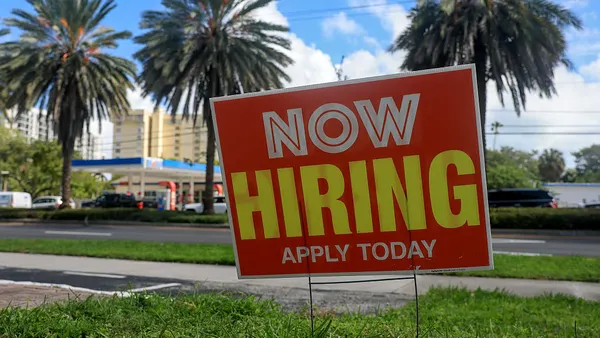Dive Brief:
- Pay increases U.S. employers use to lure talent away from competitors dropped from an average 15% to 13% in the third quarter of 2019, according to Gartner, Inc's Dec. 12 Global Talent Monitor report.
- The monitor found that just one-third of U.S. workers said they were actively job-hunting in the third quarter, a steep decline from the average 40%. Gartner said that by contrast, the global percentage of active job-hunters held steady during the same time period, at 40%.
- Gartner also noted that pay remains the prime incentive for job-changing among U.S. workers, followed by development opportunities and better management. But the drop in both job hunting and offered pay increases signals that both employers and employees view the market as tight, Gartner said.
Dive Insight:
Money remains the primary incentive for job seekers, as Gartner and other sources have acknowledged, even though wages have been relatively stagnant for several consecutive quarters. Nevertheless, job seekers have shown in various studies that some incentives can carry more weight than money. For example, a 2018 Willis Towers Watson survey found that most workers polled (61%) said they would opt for a guaranteed retirement benefit over a pay increase. However, only 38% would choose better health coverage in exchange for higher pay.
Results from a 2018 Randstad U.S. survey offered more proof that benefits can beat out money as an incentive. A majority of the 756 employees polled (66%) said benefits and perks were the biggest factor in determining whether to accept a job offer, and 61% said they would take a position that paid less for a better benefits package. In fact, the respondents said they preferred benefits that improve the quality of their lives, such as flexible work schedules — which are becoming the norm among employers' offerings — or pay-down plans for student loan debt.
Other benefits have emerged in recent years that either rival or surpass money as an incentive or perk; 70% of respondents in a Harris Poll for Instructure would be somewhat likely to leave their current job to work for a company that invests in learning and career development. And while good healthcare coverage, tuition reimbursement, recognition, and paid family or parental leave are among workers' preferred benefits, less traditional benefits and perks like meaningful work and support for causes workers value are showing up in studies on workers' considerations in looking for a job or accepting an offer.









